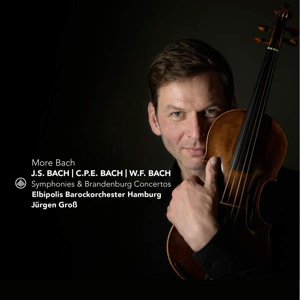
More Bach
Carl Philipp Emanuel Bach (1714-1788)
Sinfonia in C major, H659 Wq 182/3
Johann Sebastian Bach (1685-1750)
Brandenburg Concerto No. 3, BWV1048
Brandenburg Concerto No. 5, BWV1050
Wilhelm Friedemann Bach (1710-1784)
Sinfonia in F major “Dissonant” Fk67
Elbipolis Barockorchester Hamburg/Jürgen Groß
rec. 2022, Sendesaal Bremen, Germany
Challenge Classics CC72960 [54]
This programme of works for string orchestra by JS Bach and two of his sons illustrates clearly the changing musical style during the eighteenth century. However, I wouldn’t have placed CPE Bach’s Sinfonia, the work written last of the four, first. Instead, I might have ordered them Brandenburg 3, WF, Brandenburg 5 and finish with CPE.
The Elbipolis Barockorchester Hamburg has been performing for at least fifteen years, and this is its fourth recording for the Challenge Classics label; two have been reviewed for MWI. Concertos by Johann Christian Schieferdecker were warmly received by Dominy Clements who praised the gusto and fun in the performances (review), whereas Johan van Veen found the playing of symphonies by de Lalande “a little aggressive” (review). Somewhat oddly, I can see both sides in this new recording. Gusto and energy are there in spades, but smooth is not an adjective that can possibly be employed to describe the performances. That’s not to say that there is anything rough about the playing; it is precise and virtuosic, but lean and vibrato-less, and the faster movements such as the finale of Brandenburg 3 will leave you breathless. Indeed, I think theirs is now my favourite performance of this Brandenburg. The Fifth is also very good, but I will leave Trevor Pinnock’s account with The English Concert on Avie at the pinnacle.
WF’s Sinfonia comes from the 1730s during his time in Dresden and the French influence is very evident in the almost staccato dotted rhythms of the opening movement. The work is unusually structured in that the two-part minuet is placed fourth, after an Allegro which one would normally expect to be the final movement. Interesting rhythms are the dominant feature of the whole piece, far more so than melody. This suits the vibrant playing of the Elbipolis ensemble to a tee.
The CPE Sinfonia begins with an Allegro characteristic of the composer, full of nervous energy and jangling rhythms, and finishes with a sunny Allegretto, but it is the Adagio that really stands out because of its darkness, an atmosphere I hadn’t really encountered in my relatively brief exposure to the composer’s music. It is dominated by dramatic ff slashes, and the intervening softer music is, to my ears, eerie and uneasy in its dissonance. I say “to my ears” because the booklet notes describe the movement as “calm”, an adjective which seems totally inappropriate. It occurred to me that while it had been some time since I’d heard this particular work, I had no recollection of the unusual nature of the Adagio. I returned to the other version in my collection, on a Naxos disc (8.553285) played by Capella Istropolitana, which was much more “galant” in terms of its grace and gentility – there was much less contrast between the ff and pp elements – but I still wouldn’t describe it as calm. I then listened (via the Naxos Music Library) to the versions by Trevor Pinnock (Archiv Produktion 4775000) and Christopher Hogwood (Decca) and came to two conclusions: firstly, the Naxos recording was uncompetitive, and secondly that the Elbipolis version was probably in the neighbourhood of what Johan van Veen had observed for their de Lalande recording: “a little aggressive”. The Pinnock was the best, and I decided to purchase it (it’s no longer available as a physical CD, but the download can be sourced from Qobuz).
The booklet notes are good, and the sound is exceptional: I hadn’t realised quite how good it was until I started to do some comparison listening.
This has been an enjoyable listen, though certainly not an easy one. Leaving aside my quibble over the programming order, the only significant criticism I would make is that fifty-four minutes is rather meagre fare. There are plenty of other Bachs before and after JS. At the very least, one other of CPE’s symphonies could have been included; there are, after all, six in the Wq182 set. I found myself thinking that the disc’s title should have included a question mark, because I did really want more.
David Barker
Help us financially by purchasing from





















